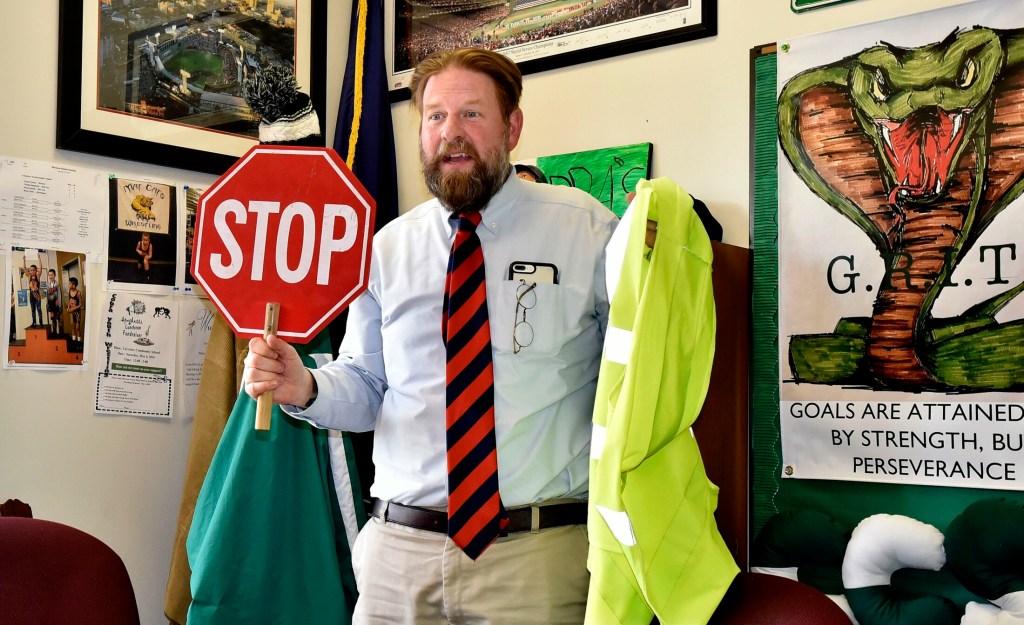ANSON — A few days per week, Carrabec Community School Principal Tom Desjardins leaves his office, gets in his pickup truck and heads to the homes of his students.

Carrabec Community School Principal Tom Desjardins has learned that many parents in the district want their children to get to school, but run into barriers thrown up by poverty that prevent that. Morning Sentinel photo by David Leaming
Carrying a folder of homework and wearing a smile along with his collared shirt and tie, he knocks on the door and waves.
“Hey, I’m here to help,” he says.
The visit to a student’s home to talk with his or her parents might be unusual and is sometimes unexpected, but Desjardins said it’s gone a long way in helping the district address the problem of students missing school.
Two years ago, Anson-based Regional School Unit 74 had one of the worst rates of chronic absenteeism — defined as a student missing at least 10% of school days — in the state. Only eight public school districts, excluding charter schools, out of 197 statewide had more students chronically absent, according to the Maine Department of Education.
But after the education department contacted the district about the problem last year, and administrators met over the summer to discuss how to address it, RSU 74 has taken a new approach that officials say has made a difference in less than one year. Now they’re sharing it with others around the state.
Across Maine, 16% of students were chronically absent in the 2017-2018 school year, according to the education department. In RSU 74, that number was almost double the state average, at 27.8%.

Now, although the school year isn’t over, the district — which includes Anson, Embden, New Portland and Solon — is far ahead of where it was at the same point last year.
At Carrabec Community School, where 36% of students were chronically absent as of mid-May last year, that number has dropped to 24%.
And at Carrabec High School, where chronic absenteeism was at 23% last year, it’s now at 14%.
The district credits their success to looking at the data behind who’s absent and addressing the problem with a positive approach that works with students and parents to address barriers to getting them to school.
Desjardins, who grew frustrated with other models aimed at helping urban schools, most of whom are equipped with a different set of resources than rural schools, said he formed his own strengths-based approach to the absenteeism problem that was informed in part by the work of Oregon-based poverty expert Donna Beegle.
“It’s a very effective approach that relies on building relationships within the community and connecting schools with families,” said Susan Lieberman, director of Count ME In!, a program focused on boosting attendance in Maine schools and sponsored by the nonprofit Educate Maine.
“It also moves from a punitive to a positive approach and moves from working in isolation on attendance issues to having a whole community focused on attendance.”
WHAT’S DRIVING ABSENCES?
RSU 74 Superintendent Mike Tracy said there are many reasons the district has struggled with student attendance, but it basically comes down to one thing: poverty.
In the school district, 70% of students are considered economically disadvantaged, according to the Department of Education. That means a family of four is making less than $46,435 per year.
“Not only do we have poverty, but on top of that, we’re rural,” Tracy said. “We’re agrarian. We’re a lumber community. There’s not a lot of industry and work here, so many moms and dads travel out of the area for work. That affects whether we can get kids back and forth to school ultimately and affects the number of days kids are in school.”
As administrators, including Desjardins, started tracking student absences more closely, they learned many of the parents in the district wanted to see their children get to school, but there were barriers that prevented that from happening.

Carrabec Community School principal and crossing guard Tom Desjardins waves to his students as they depart the school on May 31. Desjardins has reduced student absenteeism by building relationships and encouraging the whole community to focus on attendance. Morning Sentinel photo by Michael G. Seamans
Many times those barriers could be traced back to health care or transportation needs. Some recipients of MaineCare were having to travel to Augusta or Lewiston, both over an hour away from some parts of the district, to receive medical care.
If transportation challenges are thrown into the mix, it could easily turn into an all-day event to take a child to a doctor or dentist appointment, Tracy said.
Other times, older children were staying home to take care of sick parents.

RSU 74 Superintendent Mike Tracy talks about ways the district is dealing with high rates of student absenteeism, emphasizing positive means of helping people out rather than punitive measures. Morning Sentinel photo by david Leaming
“I’m not going to get angry at a person about that,” Desjardins said. “If a young woman or young man is in middle school, 14 years old, I see the correlation. I know mom’s sick. I know. And some of our folks are very sick because you don’t get the pre-care on the front end side, and sometimes (the children) have to help.”
Whatever the reason, Desjardins said in “99%” of cases, parents want what’s best for their child, and part of his approach has been to debunk the idea that students are missing school because they or their parents are lazy or don’t care.
He started thinking about what he could do to broach the subject with parents and guardians without coming off as harsh or authoritarian.
A NEW APPROACH
In the past, the district had sent letters to parents if students reached a certain number of unexcused absences, warning parents that truancy can lead to fines or a referral of the parent to the court system or the Department of Health and Human Services.
Desjardins, who came to the district two years ago from Massachusetts, said it was important to him that parents didn’t feel berated or scared. He hasn’t sent any of the letters since he took over as principal.
“A lot of our folks have a lot of different agencies that make them feel bad, for whatever reason,” he said. “They have involvement with the court system or DHHS. That’s not everybody, but there’s a correlation sometimes between these folks that are missing school and other agency involvement in their lives, and they feel threatened sometimes by it.”
Now, at 11 a.m. every morning, Desjardins asks his secretaries to forward him the voicemails of parents who have called to explain their children’s absences and provide him with a report of who is absent and whose parents haven’t called.
Because the school isn’t too big — with a population of about 280 students — he has the time to call each parent who didn’t call to report their child’s absence.
If there’s a simple fix, like sending a school van to pick up a student whose parent didn’t have gas money to get them to school after an appointment, he’ll do it.
He also came up with the idea that if a student has missed 10 days of school or whose parents can’t be reached after several absences, he will make a visit to their house.
Sometimes he brings the school social worker, a new position that was added this year to replace the assistant principal after he retired.
After Desjardins chats with the parents and delivers homework a student might have missed, the social worker can help with any services they might be struggling with such as food insecurity or heating insecurity that are interfering with school.
For the most part, the phone calls and visits are well-received, Desjardins said, although that wasn’t always the case in the beginning.
“Now I have a reputation,” he said. “People know me. They know I’m not the police or a truancy officer, so they’re more receptive.”
The approach also seems to be working.
LESSONS FOR DISTRICTS
More parents are opening up about their needs, whether it be warm clothing, food or heating assistance, and Desjardins is referring them to the new social worker.
The number of students who are chronically absent has decreased, and RSU 74 has also taken steps to share their approach with other districts.
Timothy Bell, a fifth grader at Carrabec Community School, said last year he missed about 42 days of school — about two months’ worth — because he had trouble getting out of bed and didn’t want to come to school because “it was boring.”

Carrabec Community School principal Tom Desjardins fist bumps his students as they leave the Carrabec Community School after a day of classes on May 31. Desjardins has reduced student absenteeism by building relationships and encouraging the whole community to focus on attendance. Morning Sentinel photo by Michael G. Seamans
This year, he said he’s missed much less school, around 20 days.
“Every time I’m sick, he comes and checks on me,” he said of Desjardins. “If I skip a day when I’m not sick and just don’t want to come, he comes and gets me, and my mom gets me up more often.”
In April, Tracy organized the Rural Maine Attendance Summit, which was held in Brewer and brought together leaders from more than 30 school districts and education entities to talk about the challenges facing rural school districts when it comes to student attendance.
Unlike their urban and suburban counterparts, rural districts are often smaller and don’t have some of the resources such as a public transportation system or community centers that can be leveraged to help with addressing school attendance issues.
Instead, Desjardins said there are other strengths that can be used to keep students in school, things like taking advantage of a small community where it’s not unusual for the principal to stop by your house.
“I’m trying to build bridges and highlight how much my folks are working and how tough poverty is,” he said. “It can be a barrier, but we can also work together to eliminate problems. If I do that, I feel like other principals will hop on board, too.”
Send questions/comments to the editors.







Comments are no longer available on this story